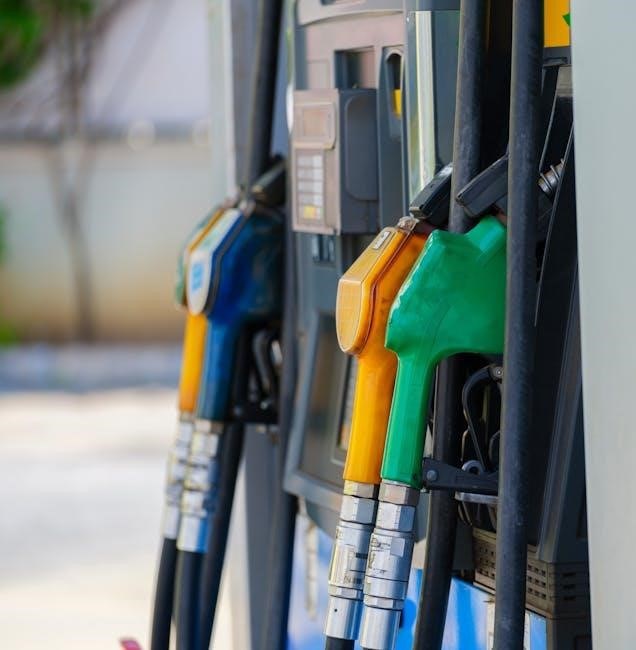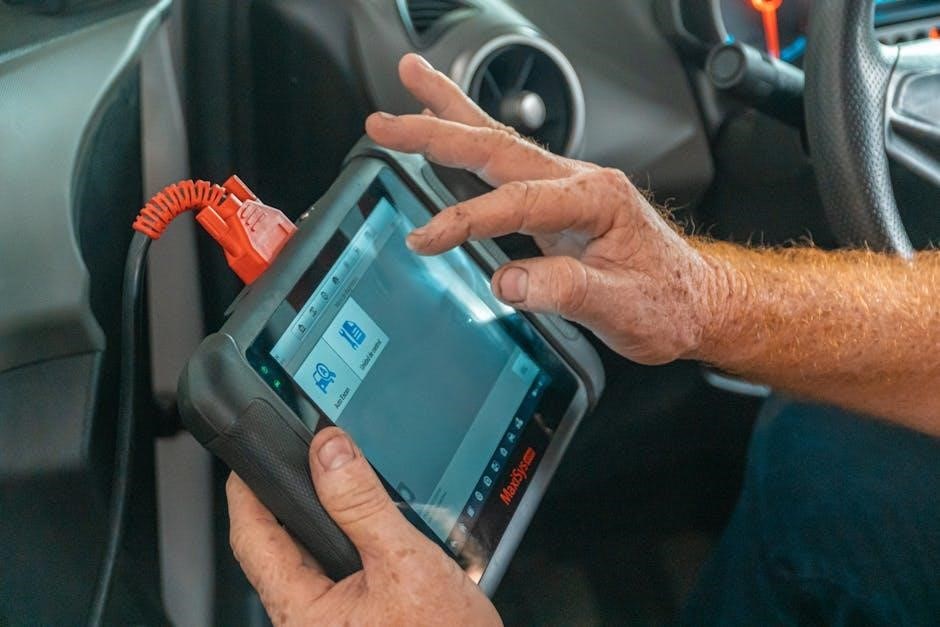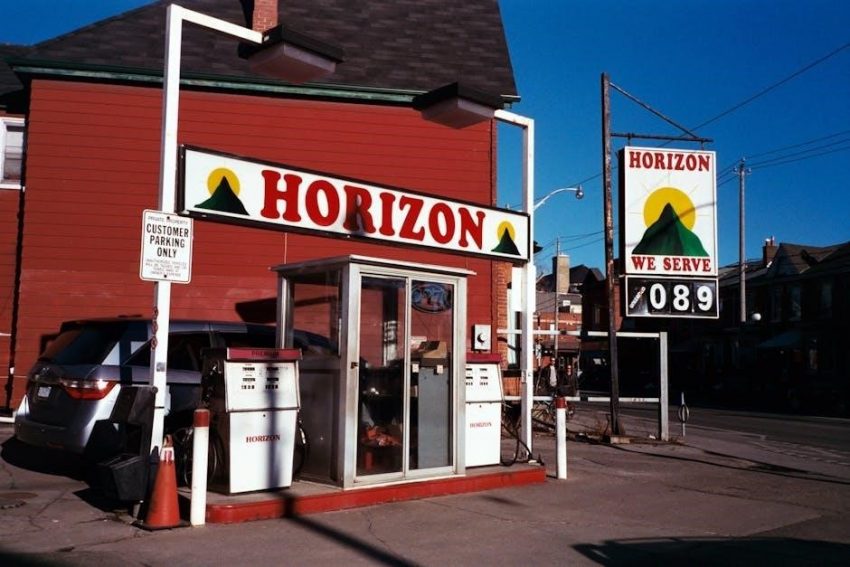Club Car gas golf carts are popular for their durability and performance, offering reliable transportation for golfing and leisure. Troubleshooting guides help address common issues like engine problems, electrical malfunctions, and fuel system hiccups, ensuring optimal functionality and longevity with proper maintenance and repair.

1.1 Overview of Club Car Gas Golf Carts
Club Car gas golf carts are renowned for their reliability and performance, making them a popular choice for both golfing and recreational use. These carts are designed with robust engines and durable components, ensuring smooth operation on various terrains. Common issues such as engine problems or electrical malfunctions can arise, but troubleshooting guides provide comprehensive solutions to address these concerns effectively. Regular maintenance plays a crucial role in extending the lifespan and functionality of these carts, allowing users to enjoy uninterrupted performance and reliability.
1.2 Importance of Troubleshooting and Maintenance
Troubleshooting and regular maintenance are essential for ensuring the optimal performance and longevity of Club Car gas golf carts. By identifying and addressing issues early, users can prevent minor problems from escalating into costly repairs. Proper upkeep also enhances safety, reliability, and overall functionality. A well-maintained cart not only performs better but also extends its lifespan. Troubleshooting guides provide step-by-step solutions, empowering users to resolve common issues independently. Regular maintenance routines, such as oil changes and filter inspections, are critical for sustaining peak performance and reducing downtime.

Common Issues with Gas Club Car Golf Carts
Gas Club Car golf carts often face issues like engine failure, poor performance, electrical malfunctions, and fuel system problems. These challenges can hinder functionality and require prompt attention.
2.1 Engine Not Starting
One of the most common issues with gas Club Car golf carts is the engine failing to start. This can be caused by a lack of spark, an empty fuel tank, or a faulty ignition switch. Additionally, a bad starter motor, clogged fuel line, or malfunctioning solenoid can prevent the engine from turning over. Regularly checking the battery connection, spark plug, and fuel system can help identify and resolve these problems quickly, ensuring your cart gets back in operation without delay.
2.2 Poor Engine Performance
Poor engine performance in gas Club Car golf carts can stem from various factors, including a dirty air filter, clogged fuel lines, or a malfunctioning carburetor. Spark plug issues, low fuel quality, or incorrect fuel-to-air mixtures can also degrade engine efficiency. Regular maintenance, such as cleaning or replacing the air filter, checking spark plugs, and ensuring proper fuel flow, can significantly improve performance. Addressing these issues promptly helps maintain the cart’s reliability and ensures a smooth driving experience.
2.3 Electrical System Malfunctions
Electrical system malfunctions in Club Car gas golf carts can cause unexpected shutdowns or failure to start. Common issues include dead batteries, loose or corroded connections, faulty solenoids, or blown fuses. Troubleshooting involves checking the battery charge, ensuring all connections are secure, and testing the solenoid for proper function. Inspecting fuses and wiring for damage is also essential. Addressing these electrical problems promptly can prevent further complications and ensure reliable operation of the golf cart.
2.4 Fuel System Problems
Fuel system issues in Club Car gas golf carts often stem from clogged fuel lines, faulty fuel pumps, or dirty carburetors. Symptoms include poor engine performance, difficulty starting, or stalling; Troubleshooting involves checking for blockages, ensuring proper fuel flow, and inspecting the carburetor for dirt or debris. Replacing the fuel filter and cleaning or replacing the carburetor can resolve many issues. Regular maintenance, such as cleaning components and ensuring fuel quality, helps prevent these problems and maintains optimal engine efficiency.

Step-by-Step Troubleshooting Guide
A systematic approach to diagnosing issues, starting with identifying symptoms, checking basic functions like ignition and battery, and progressing to more complex systems for resolution.

3.1 Identifying the Problem
Identifying the issue begins with observing symptoms like unusual noises, decreased power, or failure to start. Documenting these observations helps narrow down potential causes. Checking basic components such as the ignition, battery, and fuel levels is essential. Listen for abnormal sounds, note error lights, and test functionality to pinpoint the root cause. This step ensures that troubleshooting efforts are focused and efficient, avoiding unnecessary repairs and saving time. A clear understanding of the symptoms guides the diagnostic process effectively.
3.2 Diagnostic Tools and Equipment Needed
Essential tools for diagnosing Club Car gas golf cart issues include a multimeter for electrical testing, a fuel pressure test kit, and a spark tester. Screwdrivers, pliers, and wrenches are also necessary for accessing components. A compression tester can help identify engine problems, while a battery tester ensures proper charging. Safety equipment like gloves and goggles is crucial. Additionally, consult a detailed repair manual for specific guidance and diagrams. These tools enable effective troubleshooting and repairs, ensuring safety and efficiency in resolving issues.
3.3 Safety Precautions Before Troubleshooting
Always disconnect the battery to prevent accidental start-ups. Wear protective gear like gloves and safety glasses. Ensure the cart is on level ground and apply brakes. Avoid working near open flames or sparks when handling fuel systems. Keep fire extinguishers nearby. Never test electrical components without proper insulation. Ensure proper ventilation when working with batteries or fuel. Follow all safety guidelines in the Club Car manual to minimize risks and ensure a safe troubleshooting process.

Maintenance Tips to Prevent Future Issues
- Regular oil changes and filter replacements are essential for engine longevity.
- Inspect and clean or replace air filters to ensure proper engine airflow.
- Check spark plugs annually and replace them if worn or fouled.
- Monitor battery health and charge levels to prevent electrical issues.
4.1 Regular Oil and Filter Changes

Regular oil and filter changes are crucial for maintaining the health and performance of your Club Car gas golf cart. Engine oil lubricates moving parts, prevents overheating, and extends the lifespan of your vehicle. It is recommended to change the oil every 100 hours of operation or as specified in your owner’s manual. Always use the correct type of oil for your cart’s engine to ensure optimal performance. Additionally, replace the oil filter during each oil change to prevent contaminants from entering the engine. Proper disposal of used oil and filters is also important for environmental protection. By following these steps, you can maintain your cart’s efficiency and avoid costly repairs down the line.
4.2 Checking and Replacing Spark Plugs
Spark plugs play a vital role in the performance of your Club Car gas golf cart by igniting the fuel-air mixture in the engine. Over time, spark plugs can wear out, leading to poor engine performance, misfires, or difficulty starting the engine. Regular inspection is essential to ensure proper function. Remove the spark plugs and check for wear, fouling, or gaps. If damaged or worn, replace them with new ones suitable for your cart’s engine. Proper gapping and tightening are crucial for optimal ignition. Refer to your owner’s manual for the recommended replacement interval and specifications.

4.3 Inspecting the Air Filter
Inspecting the air filter is a crucial maintenance step for your Club Car gas golf cart. A dirty or clogged air filter can reduce engine performance, decrease fuel efficiency, and lead to poor acceleration. Locate the air filter, typically found in the engine compartment, and remove it for inspection. Check for dirt, debris, or damage. If it’s dirty, clean it with compressed air or replace it if damaged. Regular inspection ensures proper airflow to the engine, preventing issues like rough idling or difficulty starting. Refer to your owner’s manual for specific guidelines and recommendations.
4.4 Monitoring the Battery and Charging System
Regularly monitoring your Club Car gas golf cart’s battery and charging system is essential for reliable performance. Check the battery terminals for corrosion and ensure they are securely connected. Measure the battery voltage using a multimeter to confirm it’s within the recommended range. Inspect the charging system for any wear or damage, and test the charger’s output. Proper maintenance prevents issues like slow starting or electrical failures. Always follow safety guidelines when handling batteries to avoid accidents. A well-maintained battery ensures consistent power and extends the lifespan of your cart’s electrical components.

Advanced Troubleshooting Techniques
Advanced troubleshooting involves using specialized tools like multimeters for electrical diagnostics and pressure testers for fuel systems. These techniques help identify complex issues efficiently and accurately.
5.1 Using a Multimeter for Electrical Diagnostics
A multimeter is essential for diagnosing electrical issues in Club Car gas golf carts. It measures voltage, current, and resistance, helping identify faulty components like dead batteries or bad connections. By testing circuits, you can locate issues such as blown fuses or malfunctioning sensors. Always ensure the cart is turned off and safely grounded before starting diagnostics. This tool is crucial for pinpointing electrical system malfunctions efficiently and accurately, ensuring proper repairs and maintaining optimal performance. Regular use of a multimeter can prevent future electrical problems.

5.2 Fuel System Pressure Testing
Fuel system pressure testing is a critical diagnostic step for identifying issues like leaks, blockages, or faulty components. Using a pressure gauge, you can measure fuel pressure at key points, such as the fuel line and injector. This helps detect problems like clogged fuel filters, malfunctioning fuel pumps, or faulty pressure regulators. Always ensure the fuel tank is not full and relieve system pressure before testing. Regular pressure testing can uncover issues early, preventing costly repairs and ensuring smooth engine operation in your Club Car gas golf cart.
5.3 Adjusting the Carburetor
Adjusting the carburetor ensures the optimal air-fuel mixture for your Club Car’s engine. Start by locating the air-fuel mixture screws. Turn them clockwise to richen the mixture or counterclockwise to lean it out. Make small adjustments and test the engine performance after each change. Always refer to your specific model’s manual for exact procedures. Proper adjustment prevents engine damage and enhances performance; Regular maintenance, like cleaning or replacing air and fuel filters, complements carburetor tuning for a smoother ride.
Regular maintenance and timely troubleshooting ensure optimal performance of your Club Car gas golf cart; Always use the correct tools and reference the official manual for precise repairs. Seeking professional help for complex issues prevents further damage and extends the cart’s lifespan. Consistent care enhances reliability and safety, making your Club Car a dependable companion for years to come.
6.1 Summary of Key Troubleshooting Steps
Troubleshooting Club Car gas golf carts involves a systematic approach to identify and resolve issues efficiently. Start by diagnosing symptoms, checking basic systems like the battery, fuel, and air filter. Use diagnostic tools to pinpoint problems, such as multimeters for electrical issues or pressure tests for fuel system malfunctions. Always prioritize safety, disconnecting power sources before repairs. Replace faulty components and consult the official manual for guidance. Regular maintenance, like oil changes and spark plug inspections, prevents recurring issues. Addressing problems early ensures smooth operation and extends the cart’s lifespan.
6.2 Importance of Regular Maintenance
Regular maintenance is crucial for ensuring the longevity and optimal performance of Club Car gas golf carts. Routine tasks like oil changes, filter inspections, and battery checks prevent major issues from arising. By following the manufacturer’s maintenance schedule, you can identify and address potential problems early, reducing repair costs and downtime. Proper upkeep also enhances safety, reliability, and efficiency, ensuring your cart remains in peak condition for years. Consistent care not only extends the lifespan of your vehicle but also maintains its value and performance over time.
